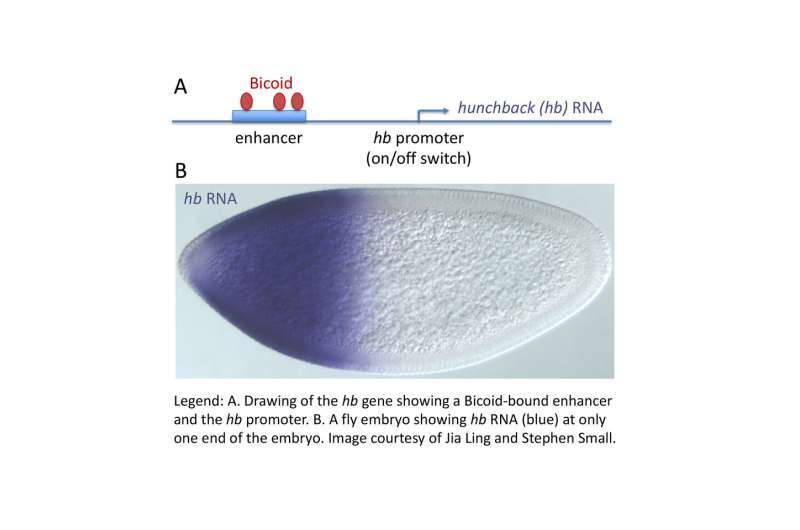Scientists uncover the intricacies of the 'on/off switch' that creates cell differentiation

A team of biologists has discovered how cells become different from each other during embryogenesis, a finding that offers new insights into genetic activity and has implications for better understanding the onset of disease and birth defects.
"Scientists have known for many years that changing which genes are turned on in a particular cell can lead to birth defects and cancer," explains Stephen Small, a professor in New York University's Department of Biology and the senior author of the paper, which appears in the journal Molecular Cell. "However, the intricacies of this activation had not been clear. Our results reveal how the process is orchestrated during an embryo's development."
Specifically, previous research had identified promoters—or "on/off" switches"—for thousands of genes. However, these studies had not delineated how these promoters are activated, leaving unclear fundamental aspects of how cells become different from each other during embryogenesis.
The Molecular Cell study focused on a gene called hunchback (hb), which makes cells in the head region of the fly embryo that are different from cells in the abdomen.
The NYU biologists uncovered hb's DNA sequence code in a region called the "hb promoter," or genetic "on/off switch."
"If the hb promoter switch is turned off, the hb gene is silent and is not expressed," explains Small. "However, if it is switched on, the gene produces an RNA copy of itself, which is required for specifying head development."
Specifically, in the embryo, the hb promoter switch is turned on by a protein called Bicoid, which binds to a different DNA sequence called an "enhancer," located very far from the hb promoter. Once bound to the enhancer, Bicoid proteins physically touch the hb promoter and subsequently flip the promoter switch on.
Small and his colleagues took advantage of a characteristic of the hb gene to help illuminate this process: the gene has two promoters, an active one that responds to Bicoid and an inactive one that does not.
"By precisely swapping sequences between the inactive and active promoters, we discovered that the active promoter contains two short sequences that are required for the response to Bicoid," notes Small. "When we mutated these sequences, the active promoter was efficiently turned off, and when we inserted them into the inactive promoter, it was efficiently turned on."
"The bodies of complex animals contain many types of cells, and each cell type is unique because it turns on a specific set of genes," he adds. "This paper describes how one of the first cell-specific genes is turned on in a particular region of the early embryo."
More information: Jia Ling et al, Bicoid-Dependent Activation of the Target Gene hunchback Requires a Two-Motif Sequence Code in a Specific Basal Promoter, Molecular Cell (2019). DOI: 10.1016/j.molcel.2019.06.038
Journal information: Molecular Cell
Provided by New York University


















